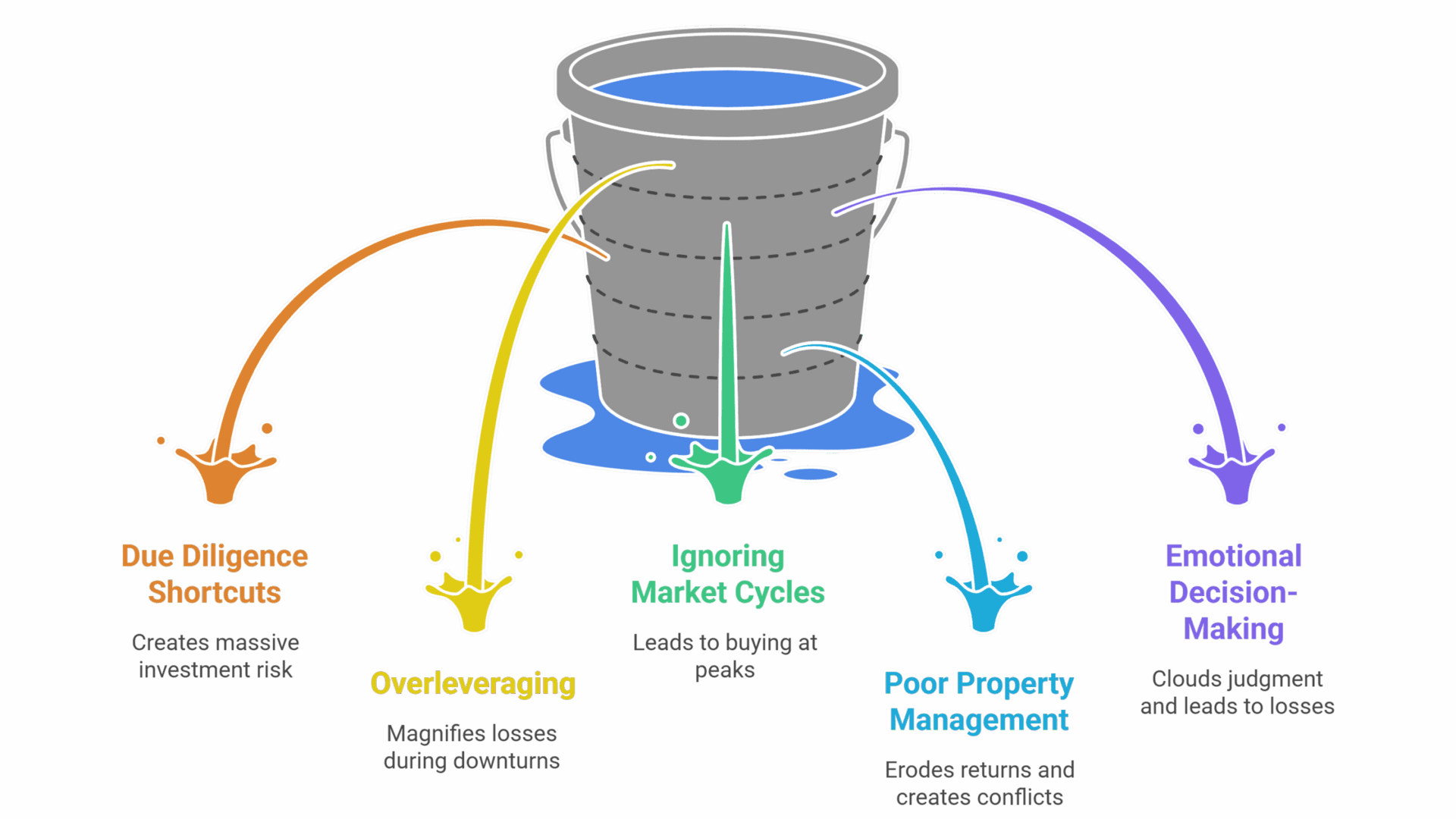Whether you’re looking to diversify your investment portfolio or build long-term wealth through income-producing real estate, understanding the complete investment cycle is crucial. This guide walks you through every stage of commercial real estate investment, from your first property analysis to executing a profitable exit strategy.
Key Takeaways
- Strategic planning is everything: Successful commercial real estate investing requires understanding property types, financing options, and whether active or passive investment aligns with your goals and resources.
- Due diligence protects your investment: Thorough financial analysis, physical inspections, and legal reviews are non-negotiable steps that separate profitable deals from costly mistakes.
- Exit strategies maximize returns: Planning your disposition approach from day one—whether through 1031 exchanges, strategic timing, or value-add improvements—ensures you capture maximum profit when it’s time to sell.
Table of Contents
- Understanding Commercial Real Estate Investment Fundamentals
- Types of Commercial Properties and Investment Opportunities
- Active vs Passive Commercial Real Estate Investing
- Commercial Real Estate Financing Options and Creative Strategies
- Essential CRE Due Diligence Process
- Understanding Commercial Property Valuation Methods
- Building and Managing Your Real Estate Portfolio
- CRE Exit Strategy Planning for Maximum Returns
- Common Mistakes to Avoid in Commercial Real Estate Investment
- FAQs
- Conclusion
Understanding Commercial Real Estate Investment Fundamentals

Commercial real estate investment differs fundamentally from residential investing. When you invest in commercial real estate, you’re acquiring properties that generate income through business operations—office buildings, retail centers, industrial warehouses, and multifamily properties with five or more units.
The commercial real estate market operates on longer lease terms, typically ranging from three to ten years, which provides more stable cash flow compared to residential properties. Tenants in commercial properties often handle maintenance responsibilities, and lease agreements generally shift more operational costs to the occupants.
What makes commercial real estate investing particularly attractive is the direct correlation between property improvements and value appreciation. Unlike residential properties where values are largely influenced by comparable sales, commercial properties are valued primarily on their income-generating potential. This means strategic improvements that increase net operating income directly increase property value.
[Interactive comparison tool: Commercial vs. Residential Real Estate Investment side-by-side comparison]
Types of Commercial Properties and Investment Opportunities
Understanding different property types helps you diversify your real estate portfolio and align investments with your risk tolerance and return expectations.
Multifamily Properties
Multifamily properties remain one of the most stable investment options in the commercial real estate sector. Properties with five or more units qualify as commercial, offering consistent demand, easier financing, and more predictable cash flow than single-family rentals. Multifamily properties tend to weather economic downturns better since housing remains a fundamental need.
Office Buildings
Office buildings range from single-tenant properties to multi-story complexes in urban centers. The office sector has evolved significantly, with flexible workspace demands and hybrid work models reshaping tenant requirements. Location, building quality, and amenities now matter more than ever in the office segment.
Retail Properties
Retail properties include everything from strip malls to regional shopping centers. Success in retail commercial property investment depends heavily on location, tenant mix, and adapting to e-commerce impacts. Strong anchor tenants and properties in high-traffic areas with good demographics continue to perform well.
Industrial Properties
Industrial properties have become increasingly valuable with the growth of e-commerce and supply chain logistics. Warehouses, distribution centers, and flex spaces offer excellent investment opportunities with typically lower maintenance costs and strong tenant demand.
Special Purpose Properties
Special purpose properties like hotels, medical facilities, and self-storage units require specialized knowledge but can offer unique investment opportunities with higher returns for experienced investors willing to manage sector-specific challenges.
Active vs Passive Commercial Real Estate Investing
One of your first decisions when you get into commercial real estate is choosing between active and passive investment approaches. Both paths offer distinct advantages depending on your time commitment, expertise, and capital availability.
Direct Ownership and Active Management
Active commercial real estate investing means direct property ownership where you handle all aspects of the investment. You select properties, negotiate purchases, secure financing, manage operations, and eventually execute the sale. This approach offers maximum control and potentially higher returns since you’re not sharing profits with partners or operators.
Active investing requires significant time commitment for property management, tenant relations, maintenance coordination, and financial oversight. You’ll need expertise in real estate analysis, market conditions, and property operations. The hands-on nature means you can implement value-add strategies directly and make quick decisions to capitalize on opportunities.
Passive Investment Structures
Passive investment options allow you to invest in commercial real estate without day-to-day management responsibilities. Real estate investment trusts (REITs) offer the most liquid passive option, trading on stock exchanges like regular stocks. REITs provide exposure to diversified commercial property portfolios with professional management, though returns are typically lower than direct ownership.
Syndications and real estate funds pool capital from multiple investors to acquire larger commercial properties. As a limited partner, you contribute capital while experienced operators handle acquisitions, management, and eventual disposition. This structure provides access to institutional-quality properties that would be unaffordable individually.
Passive investment requires less time and expertise but means surrendering control to management companies or investment managers. Returns are typically lower since operators take fees and profit shares, but you gain diversification and leverage professional real estate professionals’ expertise.
The right choice depends on your available time, industry knowledge, and whether you prefer higher potential returns with more responsibility or moderate returns with minimal involvement. Many successful investors blend both approaches, actively managing some properties while maintaining passive investments for portfolio diversification.
[Interactive quiz: “Which Investment Approach Is Right For You?” – helps determine active vs. passive based on time, capital, and experience]
Commercial Real Estate Financing Options and Creative Strategies
Securing the right financing structure can make or break a commercial property investment. Traditional commercial loans remain the foundation, typically requiring 20-30% down payment with terms ranging from 5 to 20 years. Banks and credit unions evaluate your financial strength, property cash flow, and loan-to-value ratios when underwriting commercial real estate loans.
Government-Backed and Traditional Lending
SBA 504 and 7(a) loans offer favorable terms for owner-occupied commercial properties, with down payments as low as 10% and longer amortization periods. These government-backed programs support small businesses purchasing real estate for their operations.
Creative Financing Alternatives
Owner financing provides creative alternatives when traditional lending falls short. Motivated sellers may carry a portion of the purchase price, offering more flexible terms and faster closings. This approach particularly benefits investors with strong cash flow but limited capital for large down payments.
1031 exchange structures allow you to defer capital gains taxes by reinvesting sale proceeds into like-kind commercial properties. This powerful wealth-building tool lets you upgrade properties and expand your real estate portfolio without immediate tax consequences, though strict timelines and rules apply.
Syndications and Bridge Financing
Commercial real estate syndications pool capital from multiple investors to finance larger acquisitions. As a passive investor, you contribute funds while the syndicator handles financing, acquisitions, and operations. This structure provides access to institutional-quality properties and professional capital markets expertise.
Bridge loans and hard money serve as short-term financing solutions for value-add properties or situations requiring quick closings. While carrying higher interest rates, these options provide flexibility when timing matters or properties don’t qualify for conventional financing.
Sale-leaseback arrangements allow business owners to unlock equity by selling their property to an investor while simultaneously leasing it back for operations. This creative strategy provides immediate capital while maintaining business operations and can offer tax advantages for both parties.
Understanding various financing options—from traditional mortgages to creative structures—gives you flexibility to structure deals that maximize returns while managing risk appropriately for your investment strategy.
Essential CRE Due Diligence Process
Due diligence separates successful commercial real estate investors from those who learn expensive lessons. I’ve seen promising deals unravel during inspection and others reveal hidden value through thorough analysis. Never skip corners here—comprehensive due diligence protects your investment capital and uncovers opportunities to add value.
Financial Analysis and Income Verification
Financial analysis starts with examining at least three years of operating statements, rent rolls, and tax returns. Verify actual income against projected figures, scrutinize expense ratios, and identify any deferred maintenance costs. Review existing lease terms, tenant payment histories, and upcoming renewals. Calculate the property’s net operating income by subtracting operating expenses from gross revenue, excluding debt service and depreciation.
Physical and Environmental Inspections
Physical inspection requires hiring qualified professionals to assess building systems, structural integrity, roof condition, HVAC equipment, and compliance with building codes. Environmental assessments identify potential contamination issues that could devastate your investment. Phase I environmental reports are standard, with Phase II testing conducted if concerns arise.
Legal Review and Title Work
Legal review verifies clear title, identifies easements or restrictions, and confirms zoning compliance. Title insurance protects against unknown claims, but your attorney should review survey documents, existing leases, and any pending litigation. Confirm the property’s current use matches zoning regulations and investigate any variances or conditional use permits.
Tenant and Market Analysis
Tenant verification means contacting tenants directly to confirm lease terms, satisfaction levels, and renewal intentions. Strong tenant relationships often indicate stable cash flow, while high turnover signals potential problems. Verify tenant financial stability, particularly for properties dependent on few tenants.
Market analysis examines comparable property sales, rental rates, vacancy rates in the submarket, and local economic trends. Understanding supply and demand dynamics helps you assess whether current rents are sustainable and identify growth opportunities. Economic development plans, infrastructure improvements, and demographic shifts all impact future property values.
Create a systematic due diligence checklist covering every critical detail. Most commercial contracts include inspection periods, allowing you to terminate if issues arise. Use this time wisely—findings often provide negotiating leverage for price reductions or seller concessions even if you proceed with the purchase.
[Downloadable PDF: Complete Due Diligence Checklist with critical items organized by category]
Understanding Commercial Property Valuation Methods

Accurate valuation is fundamental to making sound investment decisions in commercial real estate. Unlike residential properties valued primarily through comparable sales, commercial properties are assessed based on their income-generating capacity.
The Income Approach and Cap Rates
The income approach dominates commercial real estate analysis. This method values properties based on the income they produce, using capitalization rates (cap rates) to convert net operating income into market value. The formula is straightforward: Property Value = Net Operating Income ÷ Cap Rate.
If a property generates $200,000 in NOI annually and market cap rates are 7%, the indicated value is approximately $2.86 million. Cap rates vary by property type, location, condition, and market conditions. Understanding local cap rates for comparable properties is essential for accurate valuation.
Net Operating Income and Cash Flow
Net operating income (NOI) represents the property’s income before debt service and income taxes. Calculate NOI by subtracting operating expenses from effective gross income. Operating expenses include property management, insurance, taxes, maintenance, and utilities paid by the landlord—but exclude mortgage payments, depreciation, and capital improvements.
Cash flow analysis goes beyond NOI to show actual returns after debt service. Cash-on-cash return divides annual pre-tax cash flow by your initial equity investment, revealing the actual yield on invested capital. This metric matters more to investors than cap rates since it reflects leveraged returns.
Sales Comparison and DCF Analysis
The sales comparison approach examines recent transactions of similar commercial properties in the area. While less dominant than income approach, comparable sales provide market validation and help establish reasonable price ranges. Adjust for differences in size, location, condition, and tenant quality.
Discounted cash flow (DCF) analysis projects future cash flows and discounts them to present value using a required rate of return. This sophisticated approach accounts for rental growth, expense increases, capital improvements, and eventual sale proceeds. DCF analysis suits complex properties with varying income streams or significant value-add potential.
Professional appraisers typically use multiple valuation methods to triangulate property value. As an investor, understanding these approaches helps you identify mispriced properties, negotiate effectively, and make informed investment decisions based on realistic return expectations.
Building and Managing Your Real Estate Portfolio
Strategic portfolio construction amplifies returns while managing risk across your commercial property investments. Diversification across property types, geographic markets, and tenant industries protects against sector-specific downturns and economic cycles.
Diversification Strategy
Portfolio diversification strategy means avoiding concentration in single property types or markets. If you own multiple multifamily properties, consider adding industrial or retail properties to balance risk. Geographic diversification across different metropolitan areas protects against local economic shocks.
Tenant industry diversification matters equally. A portfolio heavily concentrated in retail tenants faces different risks than one balanced across healthcare, professional services, and logistics companies. Understanding correlation between tenant industries and economic cycles helps you build resilient portfolios.
Property Management and Operations
Property management excellence directly impacts returns. Whether self-managing or hiring management companies, operational efficiency determines profitability. Responsive maintenance, proactive tenant relations, and cost control separate good properties from great investments.
Professional property management typically costs 4-10% of gross revenue but provides expertise in tenant screening, lease enforcement, maintenance coordination, and regulatory compliance. For distant properties or investors pursuing passive investment, professional management is essential.
Value-Add and Performance Monitoring
Value-add strategies increase property value beyond passive ownership. Physical improvements like upgraded lobbies, improved parking, or enhanced landscaping attract better tenants and command higher rents. Operational improvements through better management, expense reduction, or lease restructuring boost NOI without capital investment.
Repositioning underperforming properties requires identifying why assets trade below market value. Perhaps outdated interiors, poor management, or below-market rents create opportunities. Systematically addressing deficiencies and implementing professional operations can dramatically increase property values.
Performance monitoring through regular financial reviews ensures properties meet investment objectives. Track key metrics including occupancy rates, rental income, operating expense ratios, and net operating income trends. Compare actual performance against projections and market benchmarks to identify problems early.
Maintain capital reserves for unexpected expenses, major repairs, and tenant improvements. Adequate reserves prevent forced sales during downturns and position you to capitalize on opportunities requiring quick action.
CRE Exit Strategy Planning for Maximum Returns
Planning your exit strategy before purchasing properties maximizes eventual returns and provides flexibility when market conditions change. Successful investors think about disposition from day one, not when they’re ready to sell.
Market Timing and Cycle Recognition
Market timing considerations significantly impact sale proceeds. Commercial real estate values fluctuate with economic cycles, interest rates, and capital markets conditions. Understanding market indicators helps you recognize optimal selling windows when buyer demand and financing availability peak.
Watch for signs of market tops: increasing cap rate compression, aggressive buyer competition, readily available financing, and widespread optimism. Conversely, rising cap rates, tightening lending standards, and increasing economic uncertainty signal potential headwinds.
Tax-Deferred Exchange Strategies
1031 exchange strategies defer capital gains taxes by reinvesting proceeds into replacement commercial properties within strict timelines. You have 45 days from sale closing to identify potential replacement properties and 180 days to complete the exchange. This powerful tool allows portfolio upgrading and geographic diversification while deferring tax consequences.
Working with qualified intermediaries ensures compliance with complex 1031 exchange rules. Plan ahead since you cannot access sale proceeds between transactions without disqualifying the exchange. Consider identifying multiple replacement properties to maintain flexibility if deals fall through.
Sale Preparation and Buyer Positioning
Sale preparation maximizes value through strategic improvements, financial documentation, and market positioning. Address deferred maintenance, update financial records, renew key tenant leases, and compile comprehensive property information. First impressions matter—professional marketing materials and clean, well-maintained properties attract better offers.
Timing sales to coincide with strong occupancy and recent lease renewals demonstrates stable cash flow. Buyers pay premiums for properties with limited immediate uncertainty or capital needs.
Understanding buyer types helps you position properties appropriately. Owner-users prioritize location and functionality over pure investment returns. Institutional investors seek stabilized properties with strong credit tenants and predictable cash flows. Value-add investors hunt underperforming assets with improvement potential.
Each buyer type has different priorities, financing capabilities, and price expectations. Marketing to appropriate buyer pools maximizes competition and sale proceeds.
Disposition Alternatives
Disposition strategies vary by circumstances. Traditional sales through real estate brokerage firms provide broad market exposure and competitive bidding. Off-market sales to existing relationships or direct approaches can save time and commission expenses when appropriate.
Sale-leaseback arrangements allow you to monetize property equity while maintaining operational use—ideal for business owners wanting to unlock capital. Partial sales or syndication equity raises maintain some ownership while providing liquidity.
Consider alternatives to outright sales when advantageous. Refinancing extracts equity without triggering capital gains, though increasing leverage raises risk. Property exchanges without 1031 treatment can solve unique strategic needs.
Whatever strategy you choose, engage experienced commercial real estate professionals early. Brokers, attorneys, and tax advisors help you navigate complex transactions, negotiate favorable terms, and structure deals optimizing after-tax proceeds.
[Infographic: “Understanding Different Buyer Types” – visual guide to institutional, value-add, and owner-user buyers]
Common Mistakes to Avoid in Commercial Real Estate Investment

Even experienced investors stumble without disciplined processes. Learning from others’ mistakes saves money and frustration.
Due Diligence Shortcuts
Inadequate due diligence tops the list. Rushing inspections, accepting seller-provided financials without verification, or skipping environmental assessments creates massive risk. Unknown building issues, environmental contamination, or inflated income projections can destroy investment returns. Always invest time and money in thorough due diligence.
Overleveraging and Market Timing Errors
Overleveraging properties through excessive debt magnifies losses during downturns. While leverage amplifies returns in good times, negative cash flow during vacancies or economic contractions can force sales at unfavorable prices. Maintain conservative loan-to-value ratios and adequate reserves.
Ignoring market cycles leads to buying at peaks and selling in troughs. Understanding where your market sits in the real estate cycle influences timing, property types, and investment strategies. Research local economic indicators, development pipelines, and capital markets conditions.
Management and Emotional Pitfalls
Poor property management erodes returns through high vacancy, excessive expenses, and tenant conflicts. Whether self-managing or hiring firms, active oversight ensures properties are professionally maintained and operated. Cutting corners on management rarely saves money long-term.
Emotional decision-making clouds judgment. Falling in love with properties or panic selling during market volatility leads to poor outcomes. Stick to investment criteria, maintain discipline, and base decisions on financial analysis rather than emotions.
FAQs
How much money do I need to invest in commercial real estate?
Direct ownership typically starts at $100,000-$300,000 for down payments on smaller properties. Passive investments through REITs can begin with a few thousand dollars, while syndications usually require $25,000-$100,000 minimums. Creative financing and partnerships can lower entry barriers.
What returns can I expect from commercial real estate investment?
Stabilized properties typically generate 6-12% annual returns, while value-add strategies can produce 15-25% through improvements and repositioning. REITs and passive investments usually yield 8-12% annually. Higher potential returns always come with increased risk.
Should I invest in commercial real estate through REITs or direct ownership?
REITs offer liquidity and professional management with lower returns, while direct ownership provides control and higher potential returns but requires more time and expertise. Many investors blend both approaches for balanced portfolios.
How do I find commercial real estate investment opportunities?
Build relationships with commercial brokers, network actively within the industry, and monitor listing services. Off-market deals come through industry connections and direct outreach to property owners. Prime opportunities move quickly, so strong broker relationships are essential.
When is the right time to sell a commercial property?
Consider selling when you’ve maximized value-add improvements, market conditions favor sellers with low cap rates, or the property no longer fits your strategy. Planning your exit from day one helps you recognize optimal disposition windows.
Conclusion
Commercial real estate investment offers powerful wealth-building potential when approached strategically. From understanding property types and financing options through executing thorough due diligence and planning profitable exits, success comes from informed decisions backed by solid analysis. The journey from acquisition to exit requires patience, discipline, and often guidance from experienced professionals who understand market dynamics and transaction complexities.
Ready to start your commercial real estate investment journey or discuss strategies for your existing portfolio? I’d be happy to share insights from nearly two decades helping investors navigate the commercial market. Schedule a consultation with Tolj Commercial, and let’s explore how commercial property investment can help you achieve your financial goals.




